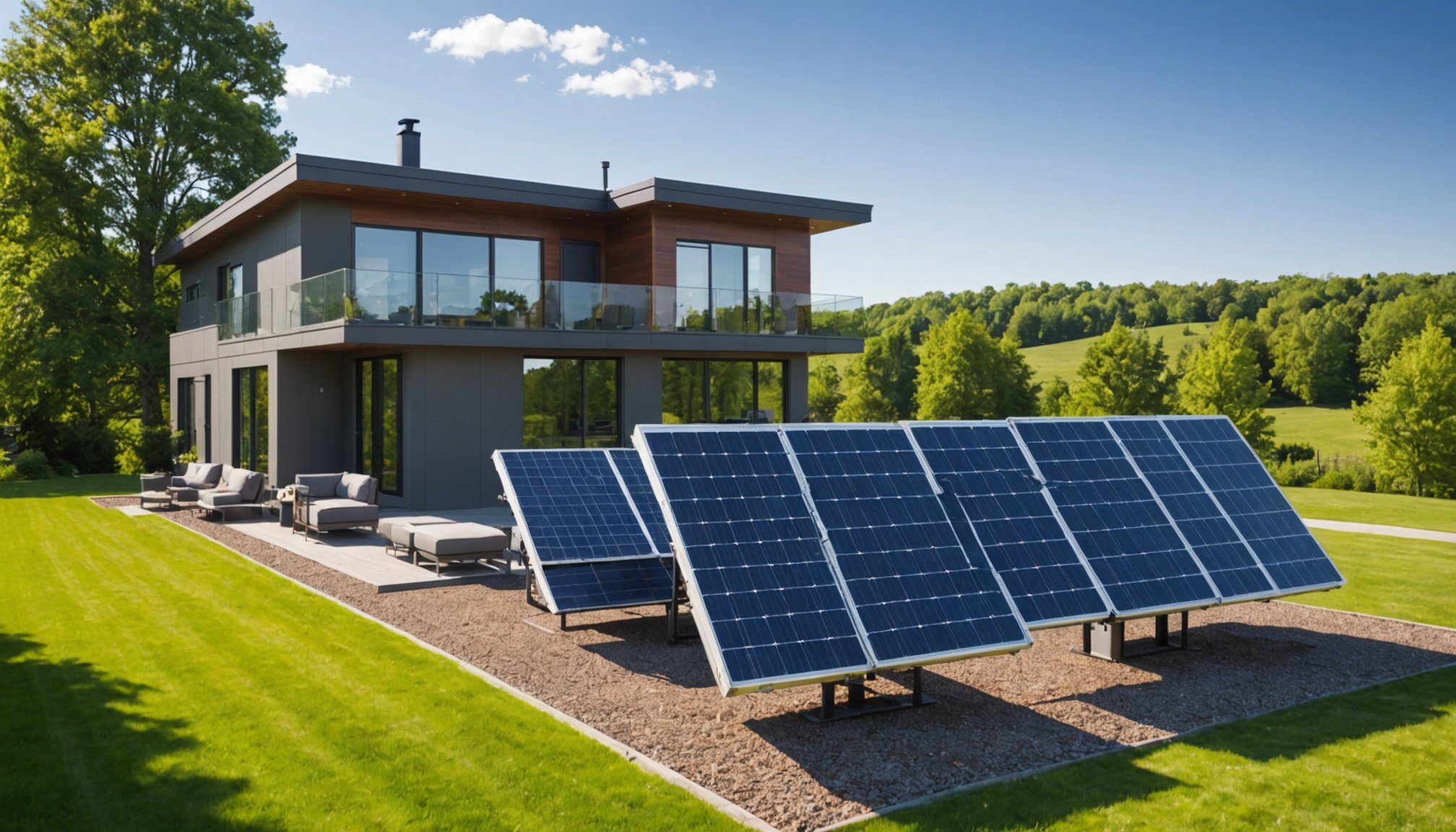Overview of Renewable Energy Storage Systems
Renewable energy storage systems are pivotal in harnessing and maintaining energy independence. They allow for the efficient use of energy generated from renewable sources like solar and wind, storing excess energy for later use when generation is low. Battery systems are the most common form of storage, providing flexibility and reliability in energy use.
Different Types of Storage Systems
There are various types of renewable energy storage systems available, each with different functionalities. Battery systems such as lithium-ion and lead-acid are popular for personal and industrial use. Batteries are central to integrating renewable resources due to their scalability and declining costs. Pumped hydro storage and compressed air energy storage are alternative methods, typically employed at larger scales.
Additional reading : Mastering the Art of Real Estate Investment: Expert Strategies to Tackle Risks in Volatile Markets
Current Trends and Advancements
The field of energy storage is rapidly advancing, with a focus on improving efficiency, capacity, and sustainability. Recent advancements in battery technology, such as solid-state batteries, promise higher energy density and safety. There is also significant investment in grid-scale storage solutions to support large-scale energy transition efforts.
These systems are essential for achieving sustainable energy goals, ensuring users and communities can maintain energy supply, even when renewable sources are not actively generating energy.
Also read : Revitalizing city heritage: the benefits of adapting historic structures for modern use
Benefits of Incorporating Renewable Energy Storage
Incorporating renewable energy storage in your lifestyle can significantly enhance your home’s energy efficiency. By storing excess energy from renewable sources, households can use this stored power during peak usage times or when generation is low. This means relying less on the grid, which can contribute to potential savings on energy bills as you optimize energy consumption patterns.
Aside from monetary savings, the environmental benefits of renewable energy storage are profound. Utilizing these systems helps reduce dependency on fossil fuels, lowering carbon footprints and contributing to sustainability. For instance, battery systems enable energy independence by allowing homeowners to keep using green energy even during periods of low or no electricity production.
Further, the economic advantages extend beyond household savings. As communities invest in renewable energy storage, it supports the green energy market, promoting technological advancement and job creation. By alleviating peak load pressures on electricity infrastructure, these systems also decrease the need for additional power plants. This shows that investing in energy storage systems doesn’t just benefit the individual but has societal and environmental ripple effects, making it an attractive solution for a sustainable future.
Selecting the Right Energy Storage Solution
Selecting the ideal energy storage system for your home involves careful consideration of several factors. One crucial aspect is battery selection. Different battery types cater to varied needs; for instance, lithium-ion batteries are often preferred for their longevity and efficiency, while lead-acid options remain budget-friendly but require more maintenance.
Understanding your home’s energy consumption patterns is essential. By assessing peak usage times and overall energy needs, you can tailor the energy storage systems to provide optimal support, ensuring energy independence. This means choosing a system that can meet your power requirements during low production periods or outages, effectively utilising stored energy for uninterrupted supply.
When considering home energy solutions, anticipate both initial and operational costs. While the upfront investment in renewable energy storage may seem substantial, the benefits of energy storage—including potential savings and bolstered efficiency—can offset these expenses over time. Ushering in renewable solutions not only fosters environmental sustainability but also aligns with financial prudence.
Ultimately, selecting the right system hinges on understanding these dynamics and aligning them with personal goals and priorities. With the proper approach, achieving a self-sufficient and eco-friendly home becomes not only possible but a practical and intelligent decision.
Installation Tips for Renewable Energy Storage Systems
Embarking on a renewable energy setup can be rewarding, especially with a DIY energy storage approach. To begin, it’s essential to understand the process thoroughly. Here’s a detailed installation guide to help.
Step-by-Step Installation Process
-
Site Assessment: Evaluate the area where the system will be installed, ensuring it’s suitable for energy storage. Check for electrical access and clearances.
-
Select Components: Choose the correct battery systems and complementary equipment. Ensure all components are compatible with your existing setup.
-
Installation: Carefully assemble and install the components. Begin with mounting hardware, followed by connecting the energy storage systems. Ensure connections are secure.
-
System Testing: Once installed, conduct rigorous tests to ensure functionality. This step checks system efficiency and readiness for operation.
Safety and Best Practices
Adhering to safety standards is crucial. Wear appropriate protective gear and ensure installations meet local regulations. Understanding renewable energy storage requirements helps prevent mishaps. Be aware of electrical hazards, and consider professional help if unsure.
Overcoming Challenges
Common challenges include space limitations and technical incompatibilities. Planning and consulting with experts can mitigate these issues. Researching renewable energy forums for insights can also offer practical solutions.
Cost Considerations for Energy Storage Systems
When evaluating energy storage cost, it’s vital to differentiate between initial and long-term expenditures. Budget planning is crucial as initial costs can be substantial due to equipment and installation expenses. However, over time, savings on energy bills and increased property value can offset these upfront investments.
There are several financing options and incentives that can help mitigate these initial costs. Homeowners might qualify for government rebates or tax incentives aimed at promoting renewable energy adoption. Additionally, some companies offer financing plans or leasing options to make the transition more accessible.
To grasp the total cost of ownership, consider both immediate and future financial characteristics. This includes potential maintenance and replacement costs, as well as the lifespan of the chosen energy storage systems. Batteries typically have a defined lifespan, influencing future expenses related to replacement.
Estimating the total cost requires a thorough analysis of your current energy usage, anticipated savings, and expected system longevity. While the initial outlay can seem daunting, it’s essential to factor in the long-term benefits and potential savings to make informed financial decisions that align with your goals for energy independence and sustainability.
Real-Life Examples and Case Studies
Renewable energy storage systems have particularly transformative impacts on homes, as seen in various real-world energy solutions. One success story is that of a family in Australia who integrated a battery storage system to manage their home’s energy needs efficiently. They achieved full energy independence while significantly reducing their carbon footprint and electricity bills. This case showcases the combination of solar panels with lithium-ion batteries to achieve outstanding results.
In Germany, another homeowner chose an innovative approach by leveraging thermal energy storage for heating. This strategy not only enhanced energy efficiency but also provided consistent warmth throughout the year, showcasing how different types of systems can be tailored to meet specific needs.
Lessons learned from these success stories underline the importance of thorough planning and appropriate battery selection. Homeowners emphasized understanding energy consumption patterns to optimize system performance.
These examples offer practical insights into maximizing the effectiveness of energy storage. They highlight not only cost savings but also resilience during grid outages or extreme weather conditions. As innovations continue, these pioneering efforts shed light on the countless possibilities for sustainable living through renewable energy storage.
Potential Challenges and Solutions
When integrating renewable energy storage systems, several challenges may arise. A common issue is the variability of power output from renewable energy sources. Addressing this requires well-sized battery systems to provide consistent energy flow. Careful problem-solving around energy demand forecasts can mitigate fluctuations, maintaining a steady energy supply even during periods of low generation.
Installation hurdles can include technical compatibility and spatial constraints. Selecting the right equipment that suits your home setup and available space is crucial. Engage with energy professionals who can offer strategic insights on system configuration and optimise spatial use, ensuring components fit well in confined areas.
Maintenance and operational costs can pose another challenge. To overcome this, explore maintenance plans that prolong system life and enhance performance. Regular system checks and updates ensure stability and efficiency over time.
For those encountering these issues, a wealth of resources is available. Community forums like those on renewable energy websites offer problem-solving advice from experienced users. Additionally, consulting local renewable energy organisations can provide valuable insights and professional guidance tailored to individual needs, ensuring lasting energy independence.
Resources for Further Support and Research
Navigating the world of renewable energy storage can be intricate. Ensuring you have access to reliable resources will bolster your journey toward energy independence. Several websites and institutions focus on energy storage resources and their diverse facets. For those keen on diving into emerging trends and innovations, research studies provide in-depth analysis, particularly pertaining to advancements in battery systems. These studies often highlight the practical applications of new technologies, aiding users in understanding what might benefit their unique needs.
Active community forums are invaluable. They offer platforms for users to share experiences and tackle any problem-solving queries. Engaging with others who have successfully implemented energy storage systems can spark ideas and provide solutions to common hurdles faced during installation or maintenance. Moreover, user groups dedicated to DIY setups frequently discuss cost-effective approaches and innovative troubleshooting techniques.
Networking with energy organisations also paves the way for support and enriched understanding. These entities often host workshops and seminars, providing firsthand expert guidance on selecting the appropriate system and maximising the benefits of renewable energy storage. By harnessing these resources, homeowners can better plan and execute energy solutions tailored to their needs.

